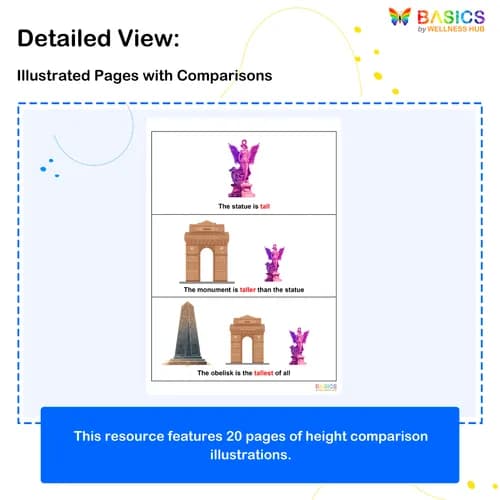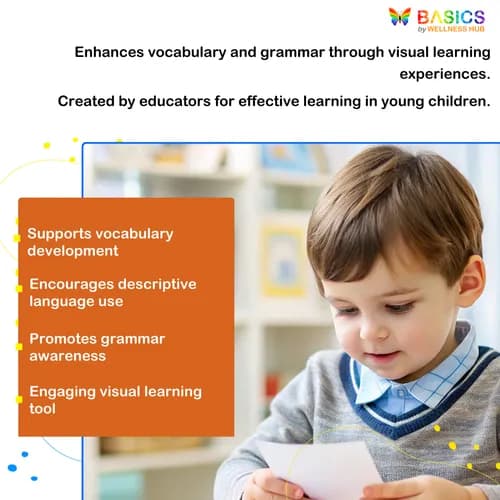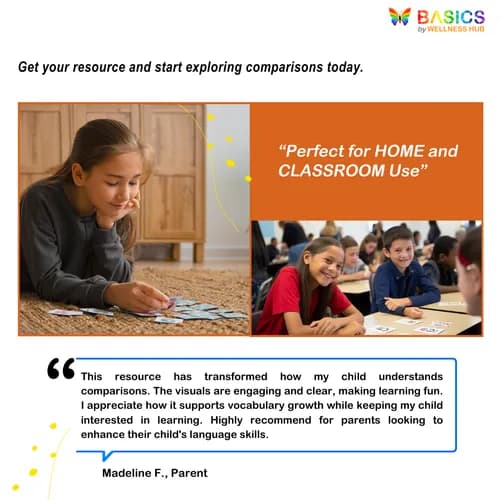





Tall & Short – Learn Comparison Words Through Pictures
₹80
₹160
50% off
0 (0 ratings)
Grade Levels
Pre-K - Grade 2 (Ages 3-7)
Content Overview
Format: Printable PDF, Total Pages: 20, Features: 60 illustrated images demonstrating tall, short, and comparison words.
Categories
Pages from the Resource
Help children learn comparison words like tall, taller, and tallest with this engaging printable PDF. Each of the 20 pages features three illustrated images that visually demonstrate height differences, accompanied by descriptive sentences. This resource supports vocabulary growth, grammar awareness, and descriptive language skills for early learners.

Page 1
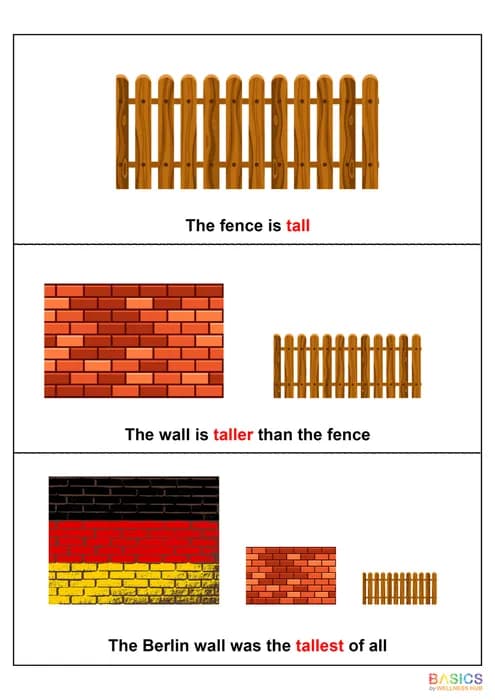
Page 2
What Users Say
0
0 ratings
5
0+
4
0+
3
0+
2
0+
1
0+
5 Stars
Product is Good to use.
1 year ago
Varsha Parent
Similar Products
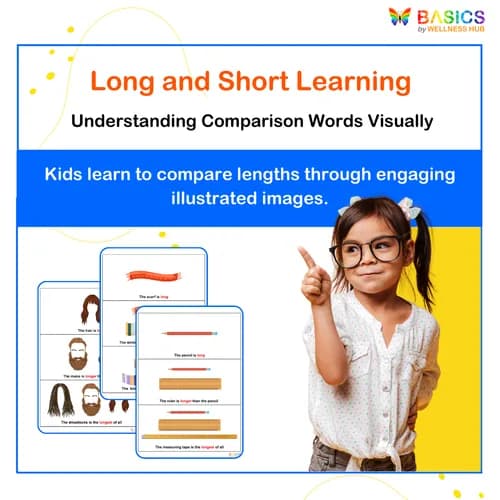
LONG & SHORT – Learn Comparison Words Through Pictures
₹ 80.00
₹ 160.00
50% off
4.9 (52 ratings)
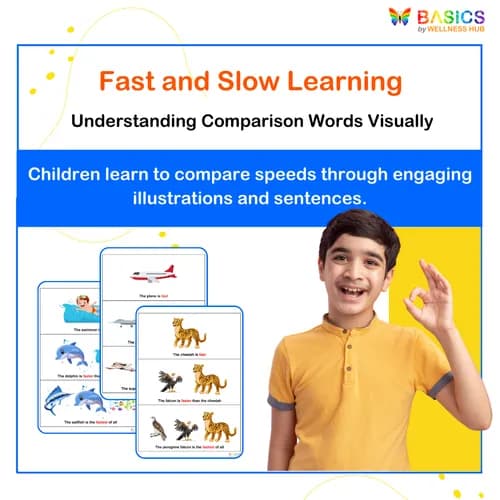
FAST & SLOW – Learn Comparison Words Through Pictures
₹ 80.00
₹ 160.00
50% off
4.8 (48 ratings)

Learning Sentences Through Concepts: Illustrated PDFs for Kids
₹ 160.00
₹ 320.00
50% off
4.7 (42 ratings)

Learning Sentences with Tall and Short: Illustrated PDF for Kids
₹ 80.00
₹ 160.00
50% off
4.6 (48 ratings)

INDIAN BOY: Learn “My” with Everyday Objects – Printable PDF
₹ 80.00
₹ 160.00
50% off
4.8 (48 ratings)
About the Product
Introduction
Understanding comparison words is a fundamental skill that enhances children's language development and critical thinking. The TALL & SHORT – Learn Comparison Words (Short, Shorter, Shortest) Through Pictures printable PDF is designed to help children grasp the concept of comparative adjectives through engaging visuals. This resource is perfect for young learners aged 4-8, making it an excellent tool for parents, teachers, and therapists who want to support vocabulary growth and grammar awareness in a fun and interactive way.
With 20 pages of vibrant illustrations, each featuring three images that demonstrate varying heights, children will learn to identify and articulate differences using descriptive sentences. For example, they will see how a rope can be described as short, while a string is shorter, and a thread is the shortest. This visual approach not only aids comprehension but also encourages children to use comparison words in their everyday conversations, fostering confidence in their language skills.
Product Details
- Product Name: TALL & SHORT – Learn Comparison Words (Short, Shorter, Shortest) Through Pictures
- Format: Printable PDF
- Total Pages: 20
- Illustrated Images: 60 total (3 images per page)
- Content Structure: Each page presents a comparison sequence (short → shorter → shortest or tall → taller → tallest) with descriptive sentences.
- Image Type: Illustrated pictures featuring people, animals, or objects of varying heights, each accompanied by a descriptive sentence.
- Designed For: Early childhood education, language development, vocabulary building, and grammar awareness.
- Best Suited For: Ages 4-8, suitable for home, classroom, and therapy settings.
Educational Benefits
1. Enhances Vocabulary Development
- Introduces children to comparative adjectives through engaging visuals and clear examples.
- Supports the expansion of descriptive language, encouraging more expressive communication.
2. Promotes Critical Thinking Skills
- Encourages children to analyze and compare objects based on height, fostering logical reasoning.
- Helps develop observational skills as they identify differences in size and length.
3. Supports Grammar Awareness
- Teaches the proper use of comparative and superlative forms in everyday language.
- Reinforces sentence structure by providing models for children to imitate and practice.
4. Engages Visual Learners
- Utilizes colorful illustrations to capture children's attention and make learning enjoyable.
- Visual aids help solidify understanding of abstract concepts like comparison, making them more relatable.
5. Encourages Interactive Learning
- Provides opportunities for children to engage in discussions about height comparisons with peers or adults.
- Facilitates hands-on activities where children can measure and compare real objects around them.
Instructions for Use
Step 1: Print the PDF
- Download and print the TALL & SHORT resource on standard A4 or Letter-sized paper.
- Consider laminating the pages for durability and repeated use in various settings.
Step 2: Read and Discuss
- Go through each page with the child, reading the descriptive sentences aloud.
- Encourage them to point out the differences in height between the illustrated objects.
Step 3: Engage in Comparison Activities
- Ask the child to describe the images using comparison words.
- Prompt them with questions like:
- "Which one is taller?"
- "Can you find the shortest object?"
Step 4: Create Real-Life Comparisons
- Use everyday items around the house or classroom to practice comparison words.
- Encourage the child to compare objects, such as toys or books, using the vocabulary learned.
Step 5: Reinforce Learning with Games
- Incorporate fun games, such as sorting objects by height or playing a matching game with the images.
- Use flashcards to quiz the child on different comparison words and their meanings.
Step 6: Regular Review
- Revisit the pages periodically to reinforce concepts and vocabulary.
- Encourage the child to create their own sentences using comparison words based on their observations.
Activities Using the Resource
1. Height Comparison Hunt
Objective: Apply comparison words to real-life objects.
How to Play:
- Go on a scavenger hunt around the house or classroom.
- Ask the child to find three objects of different heights (e.g., a book, a toy, a pencil).
- Have them describe the objects using comparison words: "The book is tall, the toy is shorter, and the pencil is the shortest."
Skill Development:
- Real-world application of vocabulary
- Observational skills
- Descriptive language practice
2. Picture Sequence Creation
Objective: Encourage creative thinking and sentence construction.
How to Play:
- Provide the child with blank paper and crayons.
- Ask them to draw three objects of varying heights (e.g., a tree, a house, a mountain).
- Have them write sentences to describe their drawings using comparison words.
Skill Development:
- Creative expression
- Sentence structure awareness
- Vocabulary expansion
3. Comparison Charades
Objective: Reinforce understanding of comparison through movement.
How to Play:
- Choose a comparison word (e.g., tall).
- The child acts out being tall, taller, or the tallest while others guess the word.
- Switch roles and have them describe their actions using complete sentences.
Skill Development:
- Kinesthetic learning
- Verbal expression
- Social interaction
4. Comparative Storytime
Objective: Integrate comparison words into storytelling.
How to Play:
- Read a storybook that includes comparisons (e.g., "The Tallest Tree").
- Pause to discuss and identify comparison words used in the story.
- Encourage the child to create their own short story using comparison words from the resource.
Skill Development:
- Listening comprehension
- Narrative skills
- Vocabulary reinforcement
5. Flashcard Matching Game
Objective: Enhance memory and recognition of comparison words.
How to Play:
- Create flashcards with images and sentences from the resource.
- Mix them up and lay them face down.
- Take turns flipping two cards to find matching pairs (image and sentence).
Skill Development:
- Memory recall
- Visual discrimination
- Language processing
6. Height Measurement Activity
Objective: Teach practical measurement and comparison skills.
How to Play:
- Use a ruler or measuring tape to measure the height of various objects.
- Have the child record their findings and compare the measurements using comparison words.
- Discuss which object is the tallest, shorter, or shortest based on measurements.
Skill Development:
- Measurement skills
- Critical thinking
- Practical application of vocabulary
Frequently Asked Questions
Q1: How does this resource help with vocabulary development?
A1: This resource introduces children to comparative adjectives through engaging visuals and clear examples. By seeing objects in varying heights and learning to describe them, children expand their vocabulary and improve their expressive communication skills. The structured approach of presenting short, shorter, and shortest helps solidify their understanding of how adjectives change in different contexts.
Q2: Can this resource be used in a classroom setting?
A2: Yes, it is perfect for classroom use. Teachers can incorporate it into lessons on adjectives, comparisons, and descriptive language. The visual nature of the resource makes it easy to engage students in discussions and activities that reinforce their understanding of comparison words, allowing for interactive learning experiences that cater to various learning styles.
Q3: What age group is this resource suitable for?
A3: The TALL & SHORT resource is designed for children in early elementary grades, typically ages 5 to 8. However, it can also be beneficial for older students who may need reinforcement in understanding comparative adjectives. The engaging visuals and simple language make it accessible for diverse learners, including those with special needs.
Q4: How can I differentiate this resource for special needs learners?
A4: This resource can be easily differentiated by adjusting the pace of instruction and providing additional support as needed. For example, you can use fewer images per page for students who may feel overwhelmed or pair the resource with hands-on activities, such as using physical objects to demonstrate comparisons. Additionally, using verbal prompts and encouraging peer collaboration can enhance understanding.
Q5: What is the delivery method for this resource?
A5: The TALL & SHORT resource is delivered as a printable PDF. After purchase, you will receive a download link via email, allowing you to print the resource at your convenience. This ensures immediate access to the material without waiting for physical shipping, making it easy to start using the resource right away.
Q6: Can I print and laminate the pages for durability?
A6: Absolutely! You are encouraged to print and laminate the pages to ensure durability, especially if you plan to use the resource in a classroom or therapy setting. Laminating the pages allows for repeated use, making it a cost-effective option for ongoing learning and practice.
Q7: What is your refund policy if I am not satisfied with the resource?
A7: Wellness Hub offers a satisfaction guarantee. If you are not satisfied with your purchase, please contact our support team within 30 days for assistance. We will work with you to resolve any issues or provide a refund if necessary, ensuring you have a positive experience with our resources.
Q8: What types of support do you offer for customers who have questions?
A8: Our customer support team is readily available to assist you with any questions or concerns you may have. You can reach out via email or through our website's contact form. We strive to respond promptly and provide detailed answers to ensure you feel confident using our resources.
Q9: Do you offer bulk licensing for schools or organizations?
A9: Yes, we do offer bulk licensing options for schools and organizations. This allows multiple users to access the resource, making it an excellent choice for educators and therapists working with larger groups. For more information on pricing and how to obtain a bulk license, please contact our support team.
Q10: Are your resources accessible for all learners?
A10: At Wellness Hub, we prioritize accessibility in our resources. Our materials are designed to be user-friendly and cater to a variety of learning styles. We also provide guidance on how to adapt activities for different needs, ensuring that all children can benefit from our educational tools. If you have specific accessibility questions, feel free to reach out to our support team for assistance.
Usage Rights and Restrictions
Allowed Usage:
- Personal use by parents, teachers, and therapists.
- Printable for classroom, home, or therapy settings.
- Can be used in group or one-on-one learning sessions.
Not Allowed:
- Reselling, redistributing, or modifying the resource for commercial use.
- Sharing publicly (e.g., on blogs, social media, or websites) without permission.
- Uploading the file to public sharing platforms.
If you need a bulk license for schools or therapy centers, please contact us.
Conclusion
The TALL & SHORT – Learn Comparison Words (Short, Shorter, Shortest) Through Pictures PDF is a powerful educational resource designed to enhance children's understanding of comparative adjectives through engaging visuals. With its 20 pages of vibrant illustrations, this resource is perfect for young learners aged 4-8, making it an ideal tool for parents, teachers, and therapists alike. By using this resource, children will not only expand their vocabulary but also develop critical thinking and grammar awareness as they learn to articulate differences in height and length.
This resource is versatile and can be effectively utilized in various settings, including homes, classrooms, and therapy sessions. Whether you're guiding a child through structured activities or encouraging them to explore comparisons in real life, this printable PDF provides a fun and interactive way to foster language development. Invest in this resource today and watch as children gain confidence in their descriptive language skills while mastering the concept of comparison!
